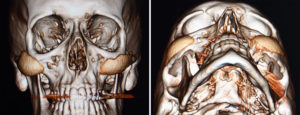Background: Augmentation of the cheeks is a frequently performed aesthetic facial reshaping procedure. While once only capable of being performed with implants, it is now more commonly done with synthetic fillers and fat. But the only assured permanent cheek augmentation result from a single effort is with the use of implants.
Like all implants placed anywhere in the body, cheek implants have the traditional medical risks of infection. Fortunately this is very low even though the intraoral route is a common incisional method of insertion. The most common risks with their use is aesthetic with an undesired outcome due to implant style, size or positioning on the bone.
In my experience cheek implant asymmetry is its most common aesthetic risk. This is a risk that is shared by any facial implant in which it is bilateral. (has a right and left side) While not commonly appreciated it is very difficult to get perfect facial implant symmetry when they have to be placed in pairs. There are a variety of reasons why implant asymmetry occurs but the fundamental reason is that the limited incisions do not allow for bilateral implant positioning assessment by direct vision.



Highlights:
- Cheek implant asymmetry is common regardless of implant style and size.
- A 3D CT scan is essential when considering cheek implant asymmetry correction.
- Repositioning of one or both cheek implants is guided by the the 3D CT scan of the good side.
Dr. Barry Eppley
Indianapolis, Indiana


